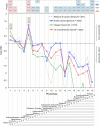Phylostratigraphic tracking of cancer genes suggests a link to the emergence of multicellularity in metazoa
- PMID: 20492640
- PMCID: PMC2880965
- DOI: 10.1186/1741-7007-8-66
Phylostratigraphic tracking of cancer genes suggests a link to the emergence of multicellularity in metazoa
Abstract
Background: Phylostratigraphy is a method used to correlate the evolutionary origin of founder genes (that is, functional founder protein domains) of gene families with particular macroevolutionary transitions. It is based on a model of genome evolution that suggests that the origin of complex phenotypic innovations will be accompanied by the emergence of such founder genes, the descendants of which can still be traced in extant organisms. The origin of multicellularity can be considered to be a macroevolutionary transition, for which new gene functions would have been required. Cancer should be tightly connected to multicellular life since it can be viewed as a malfunction of interaction between cells in a multicellular organism. A phylostratigraphic tracking of the origin of cancer genes should, therefore, also provide insights into the origin of multicellularity.
Results: We find two strong peaks of the emergence of cancer related protein domains, one at the time of the origin of the first cell and the other around the time of the evolution of the multicellular metazoan organisms. These peaks correlate with two major classes of cancer genes, the 'caretakers', which are involved in general functions that support genome stability and the 'gatekeepers', which are involved in cellular signalling and growth processes. Interestingly, this phylogenetic succession mirrors the ontogenetic succession of tumour progression, where mutations in caretakers are thought to precede mutations in gatekeepers.
Conclusions: A link between multicellularity and formation of cancer has often been predicted. However, this has not so far been explicitly tested. Although we find that a significant number of protein domains involved in cancer predate the origin of multicellularity, the second peak of cancer protein domain emergence is, indeed, connected to a phylogenetic level where multicellular animals have emerged. The fact that we can find a strong and consistent signal for this second peak in the phylostratigraphic map implies that a complex multi-level selection process has driven the transition to multicellularity.
Figures




Comment in
-
The (r)evolution of cancer genetics.BMC Biol. 2010 Jun 11;8:74. doi: 10.1186/1741-7007-8-74. BMC Biol. 2010. PMID: 20594288 Free PMC article.
References
-
- Grosberg RK, Strathmann RR. The evolution of multicellularity: a minor major transition. Annu Rev Ecol Syst. 2007;38:621–654. doi: 10.1146/annurev.ecolsys.36.102403.114735. - DOI
Publication types
MeSH terms
LinkOut - more resources
Full Text Sources
Other Literature Sources

